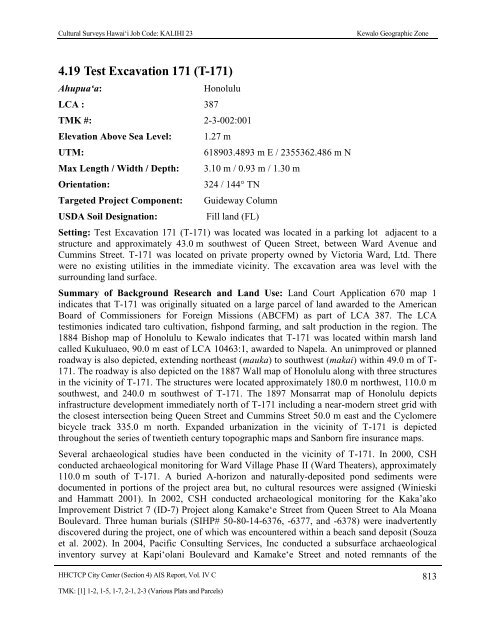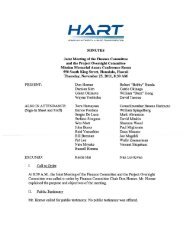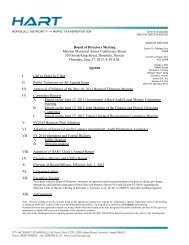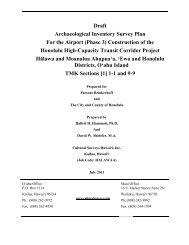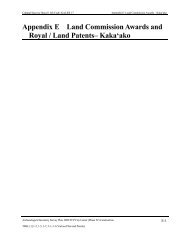4.12 Test Excavation 167 (T-167) - Honolulu Rail Transit Project
4.12 Test Excavation 167 (T-167) - Honolulu Rail Transit Project
4.12 Test Excavation 167 (T-167) - Honolulu Rail Transit Project
You also want an ePaper? Increase the reach of your titles
YUMPU automatically turns print PDFs into web optimized ePapers that Google loves.
Cultural Surveys Hawai‘i Job Code: KALIHI 23Kewalo Geographic Zone4.19 <strong>Test</strong> <strong>Excavation</strong> 171 (T-171)Ahupua‘a:LCA : 387<strong>Honolulu</strong>TMK #: 2-3-002:001Elevation Above Sea Level:UTM:Max Length / Width / Depth:Orientation:Targeted <strong>Project</strong> Component:USDA Soil Designation:1.27 mHHCTCP City Center (Section 4) AIS Report, Vol. IV C 813TMK: [1] 1-2, 1-5, 1-7, 2-1, 2-3 (Various Plats and Parcels)618903.4893 m E / 2355362.486 m N3.10 m / 0.93 m / 1.30 m324 / 144° TNGuideway ColumnFill land (FL)Setting: <strong>Test</strong> <strong>Excavation</strong> 171 (T-171) was located was located in a parking lot adjacent to astructure and approximately 43.0 m southwest of Queen Street, between Ward Avenue andCummins Street. T-171 was located on private property owned by Victoria Ward, Ltd. Therewere no existing utilities in the immediate vicinity. The excavation area was level with thesurrounding land surface.Summary of Background Research and Land Use: Land Court Application 670 map 1indicates that T-171 was originally situated on a large parcel of land awarded to the AmericanBoard of Commissioners for Foreign Missions (ABCFM) as part of LCA 387. The LCAtestimonies indicated taro cultivation, fishpond farming, and salt production in the region. The1884 Bishop map of <strong>Honolulu</strong> to Kewalo indicates that T-171 was located within marsh landcalled Kukuluaeo, 90.0 m east of LCA 10463:1, awarded to Napela. An unimproved or plannedroadway is also depicted, extending northeast (mauka) to southwest (makai) within 49.0 m of T-171. The roadway is also depicted on the 1887 Wall map of <strong>Honolulu</strong> along with three structuresin the vicinity of T-171. The structures were located approximately 180.0 m northwest, 110.0 msouthwest, and 240.0 m southwest of T-171. The 1897 Monsarrat map of <strong>Honolulu</strong> depictsinfrastructure development immediately north of T-171 including a near-modern street grid withthe closest intersection being Queen Street and Cummins Street 50.0 m east and the Cyclomerebicycle track 335.0 m north. Expanded urbanization in the vicinity of T-171 is depictedthroughout the series of twentieth century topographic maps and Sanborn fire insurance maps.Several archaeological studies have been conducted in the vicinity of T-171. In 2000, CSHconducted archaeological monitoring for Ward Village Phase II (Ward Theaters), approximately110.0 m south of T-171. A buried A-horizon and naturally-deposited pond sediments weredocumented in portions of the project area but, no cultural resources were assigned (Winieskiand Hammatt 2001). In 2002, CSH conducted archaeological monitoring for the Kaka’akoImprovement District 7 (ID-7) <strong>Project</strong> along Kamake‘e Street from Queen Street to Ala MoanaBoulevard. Three human burials (SIHP# 50-80-14-6376, -6377, and -6378) were inadvertentlydiscovered during the project, one of which was encountered within a beach sand deposit (Souzaet al. 2002). In 2004, Pacific Consulting Services, Inc conducted a subsurface archaeologicalinventory survey at Kapi‘olani Boulevard and Kamake‘e Street and noted remnants of the


